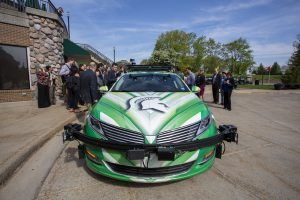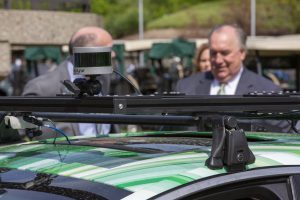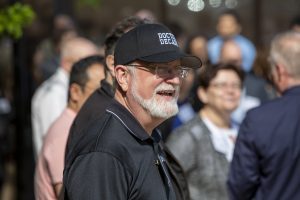Technology and engineering aren’t the only considerations ahead of the era of self-driving cars. After all, think what we’re about to unleash on society.

Attendees at the Workshop on Autonomous Vehicles in Society inspect a driverless car during the mid-May conference at the James B. Henry Center for Executive Development in Lansing. Photo by Jeff Seguin
“It’s robots in the wild,” said Brian Pentland, Main Street Capital Partners Endowed Professor in the Eli Broad College of Business. “If you go into a factory, the robots are typically in areas where you cannot go unless the power is off and the locks are carefully unlocked … Now we’re saying, ‘No problem; we’ll have thousands of them running around downtown.’”
Such ideas were at the heart of what Pentland took away from the Workshop on Autonomous Vehicles in Society in mid-May, co-sponsored by the Broad College’s Center for Business and Social Analytics – of which Pentland is the faculty director – with the MSU Institute for Public Policy and Social Research and the School of Planning, Design and Construction.
At the workshop, held at the Broad College’s James B. Henry Center for Executive Development in Lansing, experts from business, government, and academia – including the American Center for Mobility, the Nissan Research Center, University College London, KPMG and the City of Detroit – gathered to brainstorm a future where drivers, whether front-seat or back, are supplanted by none at all.

A sensor sits ready atop a driverless car while inspected by Michigan State University Interim President John Engler (background right) during an autonomous vehicle workshop hosted by MSU in mid-May. Photo by Zach Hall
Pentland saw greater consequences than just an empty driver’s seat. “The technical details translate into issues about who has access, what they’re going to pay; how cities are going to look; what our expectations are about mobility,” he said. “That was one of the big things to me; instead of being a workshop on autonomous vehicles it should have been a workshop on mobility.”
It isn’t just an engineering and technology issue; it’s also an economic, cultural, social, planning, and policy puzzle to solve.
“Technical design is social design,” Pentland said. “What optimizes the performance of the vehicle will almost certainly have an effect on cities” as currently configured. “Any kind of change you make is going to tend to generate winners and losers. That’s where the politics come in, and values.”
“Should this be technology that is available to people that would otherwise be underserved for mobility? Who, exactly, is that?” asked Pentland.
Possible consequences abound that connect with the environment. For example, autonomous cars used simply to taxi people in urban areas may be much cheaper to produce than more robust cars for general use. That may make it cheap enough to viably replace buses and mass transit.
“But if you start doing that, what happens (at a) concert or sports event where 50,000 people are going to arrive at once, each in their own autonomous vehicle? There’s no parking lot anymore,” with the demise of owner-driven cars, Pentland said. “What about the drop-off and pick-up area with thousands of cars queued up? How’s that going to work?”

Brian Pentland, faculty director of the MSU Center for Business and Social Analytics, watches a driverless car demonstration during the Workshop on Autonomous Vehicles in Society in mid-May. Photo by Jeff Seguin
Another issue involves “geofencing”: that is, the idea of operating within a designated physical area autonomous cars can navigate by various landmarks, allowing cars to seamlessly adjust to changing real-world road conditions like closures, construction, crashes, and such.
“It only works if they are operating within a geofenced area. Depending on where you draw the line of that geofence is where they’re going to work great” and at affordable price points, Pentland said, “but on the other side of that boundary, there’s nothing.”
“There are so many layers of policy and social acceptance and perception and the interdependence of things that even if the economics are very strong in a particular direction, this is by no means an inevitable thing,” Pentland said. “It’s just fascinating.”
When it will happen depends on who you believe. Some say in as little as a couple of years driverless driving will be widely apparent, with some urban areas seeing a significant amount of such traffic by 2030. “Other people say 50 years from now we’ll still be having this conversation,” Pentland said.




